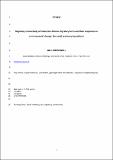Files in this item
Migratory connectivity of Palearctic-African migratory birds and their responses to environmental change : the serial residency hypothesis
Item metadata
| dc.contributor.author | Cresswell, Will | |
| dc.date.accessioned | 2015-06-02T10:10:02Z | |
| dc.date.available | 2015-06-02T10:10:02Z | |
| dc.date.issued | 2014-07 | |
| dc.identifier | 118992599 | |
| dc.identifier | bbbb2000-893a-42a2-b4b2-fa11943651b6 | |
| dc.identifier | 84902079737 | |
| dc.identifier | 000337568100001 | |
| dc.identifier.citation | Cresswell , W 2014 , ' Migratory connectivity of Palearctic-African migratory birds and their responses to environmental change : the serial residency hypothesis ' , Ibis , vol. 156 , no. 3 , pp. 493-510 . https://doi.org/10.1111/ibi.12168 | en |
| dc.identifier.issn | 0019-1019 | |
| dc.identifier.uri | https://hdl.handle.net/10023/6726 | |
| dc.description | Date of Acceptance: 04/05/2014 | en |
| dc.description.abstract | In most long-distance migratory birds, juveniles migrate without their parents and so are likely to lack detailed knowledge of where to go. This suggests the potential for stochasticity to affect their choice of wintering area at a large scale (> 1000 km). Adults, in contrast, may re-use non-breeding sites that promote their survival, so removing uncertainty from their subsequent migrations. I review the evidence for large-scale stochastic juvenile site selection followed by adult site fidelity, and then develop a ‘serial-residency’ hypothesis based on these two traits as a framework to explain both the migratory connectivity and the population dynamics of migrant birds and how these are affected by environmental change. Juvenile stochasticity is apparent in the age-dependent effects of weather or experimental displacement on the outcome of migration and in the very wide variation in the destinations of individuals originating from the same area. Adults have been shown to be very faithful to their wintering grounds and even to staging sites. The serial residency hypothesis predicts that migrants that show these two traits will rely on an individually unique but fixed series of temporally and spatially linked sites to complete their annual cycle. As a consequence, migratory connectivity will be apparent at a very small scale for individuals, but only at a large scale for a population, and juveniles are predicted to occur more often at less suitable sites than adults, so that survival will be lower for juveniles. Migratory connectivity will arise only through spatial and temporal autocorrelation with local environmental constraints, particularly on passage, and the distribution and age structure of the population may reflect past environmental constraints. At least some juveniles will discover suitable habitat that they may re-use as adults, thus promoting overall population-level resilience to environmental change, and suggesting value in site-based conservation. However, because migratory connectivity only acts on a large scale, any population of migrants will contain individuals that encounter a change in suitability somewhere in their non-breeding range, so affecting average survival. Differences in population trends will therefore reflect variation in local breeding output added to average survival from wintering and staging areas. The latter is likely to be declining given increasing levels of environmental degradation throughout Africa. Largescale migratory connectivity also has implications for the evolutionary ecology of migrants, generally because this is likely to lead to selection for generalist traits. | |
| dc.format.extent | 646879 | |
| dc.language.iso | eng | |
| dc.relation.ispartof | Ibis | en |
| dc.subject | Age-dependent site selection | en |
| dc.subject | Distribution | en |
| dc.subject | Migrant declines | en |
| dc.subject | Migration | en |
| dc.subject | Multiple jeopardy | en |
| dc.subject | QH301 Biology | en |
| dc.subject.lcc | QH301 | en |
| dc.title | Migratory connectivity of Palearctic-African migratory birds and their responses to environmental change : the serial residency hypothesis | en |
| dc.type | Journal item | en |
| dc.contributor.institution | University of St Andrews. School of Biology | en |
| dc.contributor.institution | University of St Andrews. Scottish Oceans Institute | en |
| dc.contributor.institution | University of St Andrews. Institute of Behavioural and Neural Sciences | en |
| dc.contributor.institution | University of St Andrews. St Andrews Sustainability Institute | en |
| dc.contributor.institution | University of St Andrews. Centre for Biological Diversity | en |
| dc.identifier.doi | 10.1111/ibi.12168 | |
| dc.description.status | Peer reviewed | en |
This item appears in the following Collection(s)
Items in the St Andrews Research Repository are protected by copyright, with all rights reserved, unless otherwise indicated.

